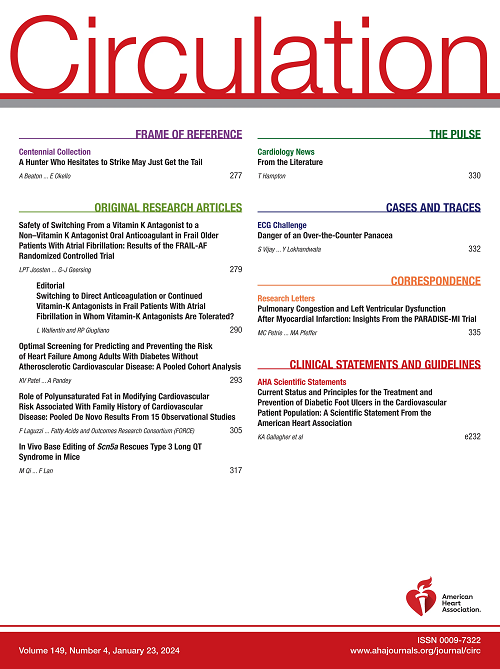PYGM Protects Against Myocardial Infarction by Enhancing Glycogenolysis and Facilitating Autophagic Flux.
IF 38.6
1区 医学
Q1 CARDIAC & CARDIOVASCULAR SYSTEMS
引用次数: 0
Abstract
BACKGROUND PYGM (muscle glycogen phosphorylase), the rate-limiting enzyme in glycogenolysis, plays an indispensable role in maintaining cardiac energy metabolism. However, the role of PYGM in the pathogenesis of myocardial infarction (MI) remains unclear. METHODS The expression profiles of PYGM in cardiac tissues and plasma samples from subjects with MI were assessed using immunoblotting. The role of PYGM in MI was determined by evaluating the effects of PYGM deficiency and its replenishment through adeno-associated virus-mediated PYGM expression in mice with MI. RESULTS We found that circulating PYGM levels and their cardiac contents were significantly decreased in patients with MI, which was associated with impaired cardiac function. Loss of PYGM significantly exacerbated MI-induced cardiac dysfunction and damage in mice, and replenishment of PYGM profoundly reversed these adverse effects. Mechanistically, PYGM enhanced glycogenolysis by activating glycolysis and the pentose phosphate pathway, thereby improving cardiac energy homeostasis and mitigating oxidative stress. In addition, PYGM improved MI-induced autophagic flux obstacles and alleviated MI-induced cardiac damage by suppressing the expression of Thbs1 (thrombospondin-1). Moreover, genetic deficiency or pharmacological blockage of autophagy attenuated the protective effects of PYGM against MI-induced cardiac injury, and cardiac-specific knockdown of Thbs1 substantially improved the adverse impact of MI on cardiac dysfunction and damage in PYGM-null mice. CONCLUSIONS PYGM safeguards against MI-induced myocardial injury by stimulating glycogenolysis and promoting autophagic flux, thus preserving myocardial energy homeostasis.PYGM通过促进糖原溶解和促进自噬通量来预防心肌梗死。
背景pygm(肌糖原磷酸化酶)是糖原分解的限速酶,在维持心脏能量代谢中起着不可缺少的作用。然而,PYGM在心肌梗死(MI)发病机制中的作用尚不清楚。方法采用免疫印迹法检测心肌梗死患者心肌组织和血浆中PYGM的表达谱。通过评估PYGM缺乏及其通过腺相关病毒介导的PYGM表达补充对心肌梗死小鼠的影响来确定PYGM在心肌梗死中的作用。结果我们发现心肌梗死患者循环PYGM水平及其心脏内容物显著降低,这与心功能受损有关。PYGM的缺失显著加重了心肌梗死引起的小鼠心功能障碍和损伤,而PYGM的补充则深刻地逆转了这些不良反应。在机制上,PYGM通过激活糖酵解和戊糖磷酸途径促进糖原分解,从而改善心脏能量稳态,减轻氧化应激。此外,PYGM通过抑制Thbs1(血栓反应蛋白-1)的表达,改善了mi诱导的自噬通量障碍,减轻了mi诱导的心脏损伤。此外,基因缺陷或自噬的药物阻断减弱了PYGM对心肌损伤的保护作用,心脏特异性敲低Thbs1可显著改善心肌对PYGM缺失小鼠心功能障碍和损伤的不利影响。结论spygm通过刺激糖原分解,促进自噬通量,从而维持心肌能量稳态,对心肌损伤具有保护作用。
本文章由计算机程序翻译,如有差异,请以英文原文为准。
求助全文
约1分钟内获得全文
求助全文
来源期刊

Circulation
医学-外周血管病
CiteScore
45.70
自引率
2.10%
发文量
1473
审稿时长
2 months
期刊介绍:
Circulation is a platform that publishes a diverse range of content related to cardiovascular health and disease. This includes original research manuscripts, review articles, and other contributions spanning observational studies, clinical trials, epidemiology, health services, outcomes studies, and advancements in basic and translational research. The journal serves as a vital resource for professionals and researchers in the field of cardiovascular health, providing a comprehensive platform for disseminating knowledge and fostering advancements in the understanding and management of cardiovascular issues.
 求助内容:
求助内容: 应助结果提醒方式:
应助结果提醒方式:


